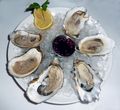13 Feb Hunting and Gathering: Valentine's Day Oysters
by Lisa Barlow
 It’s Valentine’s Day and while you may be content to buy your love a pretty box of chocolates, there are a host of other foods that can convey your message more effectively.
It’s Valentine’s Day and while you may be content to buy your love a pretty box of chocolates, there are a host of other foods that can convey your message more effectively.
Since ancient times clever cooks have concocted seductive recipes to tempt their paramours and the list of edible aphrodisiacs they have come up with is long and varied. Some foods merely look suggestive. Others have been clinically proven to help get the job done.
In the first category, bananas top the list. Mae West’s famous query says it all: Is that a banana in your pocket …or are you happy to see me? Asparagus and carrots, like figs and cherries, also arouse some fertile imaginations. But then just about anything can excite some folks. In her book Aphrodite, A Memoir of the Senses, Author Isabel Allende says she tested her recipes on friends over 40 “since even a cup of chamomile turns on the young.”
For the literal minded, there is the sea cucumber, a famed Asian love potion ingredient. A long and gelatinous echinoderm, it squirts sticky white threads at its predators when under attack. However, it is sold in a shriveled, dried state and in powdered form in most Chinese pharmacies, so I’m not sure how its amorous properties hold up, so to speak.
Many foods come by their reputations scientifically. Chocolate does contain phenylethylamine, the chemical that releases dopamine in the brain during orgasm. Garlic contains allicin, which increases blood flow throughout the body. Similarly, ginseng root contains a host of libido enhancing chemicals that are said to rival those in Viagra. Avocados, strawberries, chili peppers, pine nuts, basil and honey also show up on many endorphin-producing ‘top ten’ lists.
Oysters are perhaps the most famous culinary stimulants that straddle both categories. They are both yonic (the female equivalent of phallic) and proven to elevate testosterone levels due to their high zinc content. They also have the longest history of success in the lore of love.
Aphrodite, the Greek Goddess of Love, from whence we get the word “aphrodisiac”, is said to have sprung forth from the foamy sea upon an oyster shell. Roman emperors were so enamored of the mollusk’s amorous properties that they sent their slaves all the way to the English Channel to collect them. In fact, the very first cookbook of record, written by Apicius, includes a recipe for preserving oysters on their journey from the sea to the table.
But it wasn’t until Casanova recorded his sexual exploits that we actually see the seductive power of the oyster. Not only did he breakfast on 50 oysters every morning in order to maintain his energy, he employed them in the service of his art. Most famously tempted were the two novitiates he kissed by passing raw oysters back and forth between his mouth and theirs.
The way you eat your oysters is up to you. But I suggest serving them raw upon a bed of ice, paired with a nice glass of champagne. Opening oysters is simple enough, but it requires a bit of patience and practice. Click here for a basic tutorial.
 Lisa Barlow is a writer and photographer who divides her time between New York, Telluride and San Pancho, Mexico. An enthusiastic omnivore, she specializes in stories about food.
Lisa Barlow is a writer and photographer who divides her time between New York, Telluride and San Pancho, Mexico. An enthusiastic omnivore, she specializes in stories about food.


Sorry, the comment form is closed at this time.